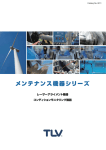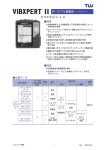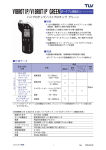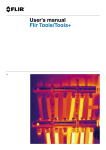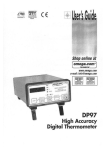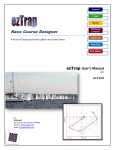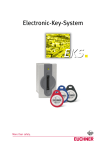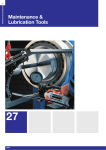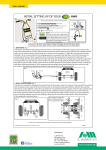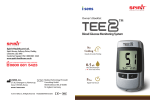Download to the issue of - Institution Of Diagnostic Engineers
Transcript
Diagnostic FC_Layout 1 12/03/2010 09:29 Page 1 ISSN 0269-0225 No. 170 March/April 2010 Diagnostic Engineering THE JOURNAL OF THE INSTITUTION OF DIAGNOSTIC ENGINEERS Increase reliability, reduce downtime and decrease operational costs with Machine Condition Monitoring from National Instruments. See page 7 for more. T H E O F F I C I A L M E D I A PA RT N E R O F T H E I D E Project2_29_H&P_0308 15/03/2010 15:01 Page 1 Market leading Temperature and Position sensors! Infra Red non-contact Temperature sensors & imagers Extensive 56 page catalogue describes sensors for almost all applications and environments: -40 to +3300 °C; upto 250 °C ambient without cooling; built in laser sighting; from 1µm to 14 µm; wavelengths for specific materials, including Metals, Glass, Plastics. New: Inline fixed mount and handheld thermal imagers. Market leading specifications at very competitive prices LVDT, Inductive, Eddy current and Draw wire sensors Large range of over 250 different models available from stock! No matter what your process – we have a sensor to suit your requirement. Measurement ranges from 0.5mm to 60m! Extremely robust and stable in the most demanding applications. Using either Laser Triangulation or Time of Flight sensors enable measurements from single microns to 3Km! Compact and robust sensors with integrated controllers. Low cost OEM and entry level models to highest precision in class. Select analogue, serial, BUS interfaces. Call now to request your selection guide Visit us: Controls Show & ves Dri 26 June 8-10, NEC, Stand D23 Laser sensors Largest selection of sensors worldwide. Call to speak to a sensor expert +44 (0) 151 355 6070 or visit www.micro-epsilon.co.uk Comment_Layout 1 16/03/2010 12:43 Page 1 EDITOR’S COMMENT Diagnostic Engineering is published by DFA Media Limited on behalf of The Institution of Diagnostic Engineers Editor’s comment Registered Office 16 Thistlewood Road Outwood, Wakefield West Yorkshire, WF1 3HH Tel: 44 (0) 1924 821000 Fax: 44 (0) 1924 821200 E-mail: [email protected] Web: www.diagnosticengineers.org Is maintenance being taken seriously in the UK? This year’s Maintec exhibition in Birmingham, which the IDE exhibited at and received some very positive feedback and member applications, traditionally focuses on condition monitoring and predictive maintenance, was an encouraging display of the latest asset management solutions. It afforded maintenance professionals across Britain an opportunity to source the kinds of predictive maintenance technologies to help tackle the current business environment. But there is still a feeling that UK industry is looking at the bottom line and hasn’t used this exhibition to take advantage of the various opportunities on display. Investment in maintenance is one area industry in Britain should be concentrating their efforts towards, moving from reactive to proactive strategies. Failure to maintain critical items of manufacturing plant leads to breakdowns, causing downtime on the whole process, loss of productivity and a serious blow to profitability, not to mention the health and safety implications of failing to carry out routine maintenance. This is the message that Maintec exhibition attempts to highlight. In challenging times, when budgets for new capital expenditure are tight, effectively maintaining existing assets and machinery is paramount, but I shouldn’t have to explain this or should I? Unfortunately I do. Speaking to exhibitors and visitors at this year’s Maintec exhibition in the UK, it brought home to me the increasing frustration within the UK maintenance sector that large chunks of industry are still failing to understand or appreciate that maintenance should be a given. Like quality control, maintenance should be given the same level of importance. The main issue that surfaces with alarming regularity is that of return on investment (ROI), and persuading those with the purse strings to part with the cash based on the potential savings that could be made from investing in maintenance products or services and even training. Too many businesses still don’t want to listen to the voice of reason and are simply looking at the bottom line, failing to see the bigger picture. One thing is certain however, machinery failure will mean downtime, and downtime costs money, and lots of it! Would any of us throw hundreds of thousands of Pounds into a bin? I doubt it, but this is effectively what some businesses are doing by looking at maintenance as a cost rather than as an investment for their business to prevent unnecessary downtime. Reducing costs, improving efficiency and eliminating costly machine failures are vital, and all the products, systems and services on show at this year’s event were highlighting how to help achieve these goals. With maintenance professionals under more pressure than ever to make efficiency savings, optimise plant availability, and extend equipment longevity, there were some positive signs at this year’s show that maintenance was beginning to rise in importance but that maybe it’s taking longer than many expected. Manufacturers up and down Britain should be using any opportunity available to them to look at new ways to development their maintenance strategy and Maintec was an ideal opportunity that I would argue was unfortunately very clearly missed. President: Dr.David Adams PhD., MIPM(SA), FIDiagE Chairman: Steve Reed MIDiagE INSTITUTION OFFICERS Company Secretary/Treasurer: Andy Garnor MIDiagE. Vice-Chairman: Chris Gilbert MIDiagE., MIOA Executive Officer: Bill Parker MIDiagE Membership Selection Officer: Chris Gilbert MIDiagE., MIOA. Council Members: Jeff Casciani-Wood FIDiagE Malcolm Hedley-Saw MIDiagE. Articles, photographs, manuscripts and other contributions for publication to: The Editor Diagnostic Engineering DFA Media Ltd Cape House, 60a Priory Road Tonbridge TN9 2BL or by e-mail: [email protected] ISSN 0269-0225 Diagnostic Engineering is free of charge to members of the Institution of Diagnostic Engineers. It is also available on subscription. For details contact Head Office. S N GI NE E E INS TI TU O F DIA G N O CE RS TH ON TI TI The views expressed by contributors are their own and are not necessarily those of the publishers, the editor or the Council of Management of the Institution of Diagnostic Engineers. Whilst every care is taken to ensure that the contents of the Journal are accurate, we can accept no responsibility for these, or for the effect of errors or omission. Likewise, while every care is taken when accepting advertisements, we cannot accept responsibility for the contents of these or for unsatisfactory transactions. We will however investigate any complaints. www.diagnosticengineers.org Bluts Aaron Blutstein MIDiagE Editor Diagnostic Engineering 00Diagnostic Engineering March/April 2010 01 0 IDE Code_Layout 1 09/03/2010 14:41 Page 2 E INS TI TU TH 14. To develop the science, practice and business of diagnostic engineering and allied technologies. 15. To encourage and improve the technical, financial, business, managerial and general knowledge of all persons engaged in the practice of fault and failure diagnosis, condition monitoring, post-mortem examination,accident investigation and allied activities. RS 13. To arrange consortia of specialist diagnostic engineers to perform specific advisory/consultancy projects as required. S N GI NE E 12. To establish and maintain contacts with persons and/or organisation concerned with the employment of diagnostic engineers and consultants. O F DIA G N O CE 11. To promote the education and training of persons whether resident in the United Kingdom or elsewhere in all matters relating to diagnostic engineering and allied technologies. ON TI TI THE OBJECTIVES OF THE INSTITUTION Definition A ‘Diagnostic Engineer’ shall be any person capable of contribution to the art or science of determining the existence of a problem in a machine, plant, system or structure and/or appraising the cause(s) of a failure which may have taken place and/or assessing the condition or vulnerability of such machine, plant, system or structure either during use or while under development. Interpretation It is accepted that through a diagnostic capability or a special knowledge of a failure and deterioration modes, reliabilities and hazards a person will be able to contribute to a satisfactory assessment of the causes of a defect and able to contribute to the identification of remedial action to cure the defect and prevent failure. Motivation 16. To compile and classify information and particulars relating to the expert services rendered by members of the Institution. 17. To disseminate information and particulars relating to the expert services rendered by members of the Institution. 18. To stimulate efficiency in diagnosis and to elevate the position of those connected therewith in skilled practical employment. 19. To foster intelligent appreciation of the facilities existing for the provision of education and research. Employers are invited to recognise that persons who have joined have shown distinguished interest in developing and extending their technical skill. Rewards Prizes up to £500 in value are offered annually for the best brief accounts of interesting diagnostic cases. Activities The Institution shall arrange and subsidise: 10. To facilitate the exchange of information, ideas and practice by the publishing of such information as shall be of interest to diagnostic engineers. 11. To render advice and aid in the exploitation of inventions and to make known their nature and merits. 12. To assist in obtaining employment and to help engineers and others to find competent staff. 01 2 Diagnostic Engineering March/April 2010 Regular Newsletters to members Regular notices of services available from members will be (distributed free of charge to members) to interested parties. These notices will also be displayed at times on the Institution’s web page. Certificate A Membership Certificate is issued to all members. www.diagnosticengineers.org Diagnostic Contents_Layout 1 16/03/2010 09:49 Page 3 CONTENTS Editor: Aaron Blutstein BA (Hons) MIDiagE Tel: (01732) 370340 e-mail: [email protected] Advertisement Manager: Roberto Tondina Tel: (01732) 370348 e-mail: [email protected] Display Sales Executive: Sarah Galbraith Tel: (01732) 370342 e-mail: [email protected] Internal Sales Executive: Alistair McKay Tel: (01732) 370347 e-mail: [email protected] DFA Direct Sales Manager: Chris Lever Tel: (01424) 775941 e-mail: [email protected] Production Manager & Designer: Chris Davis Tel: (01732) 370340 e-mail: [email protected] Circulation Manager: Andy Kirk Tel: 0845 602 7390 e-mail: [email protected] Inside this issue: March/April 2010 PAGE 1 Editor’s comment PAGE 2 Institution of Diagnostic Engineers Code PAGE 4 News PAGE 6 Feature Temperature Measurement PAGE 8 Industry products Finance and Credit Control: Clare Jackson Tel: (01732) 370340 e-mail: [email protected] PAGE 11 Publishing Director: Ian Atkinson Tel: (01732) 370340 e-mail: [email protected] Published by: DFA Media Limited, Cape House 60a Priory Road Tonbridge Kent TN9 2BL Tel: (01732) 370340 Fax: (01732) 360034 [email protected] www.pwemag.co.uk PAGE 8 Chris Jones discusses two key parameters in selecting the most suitable infrared temperature sensor. Customer Liaison: Katherine Cairns Tel: (01732) 370340 e-mail:[email protected] Sales Director: Ryan Fuller Tel: (01732) 370340 e-mail: [email protected] PAGE 6 Diagnostic Engineering’s regular products and services round-up. Member contributions PAGE 11 Nobody, could have been more surprised than John Allerton when he received a letter from the MegaInterest Finance Company informing him that he had not paid the first instalment on his Bentley Arnage Turbo, which according to the letter, he had taken delivery of just a month previously. What made it even more surprising was that - well, you have guessed it, he did not buy or possess such a magnificent car. Douglas Wragg FIDiagE reports. Error Codes and the tale of the phantom paper jam by John Sayer FIDiagE. COVER STORY PAGE 7 A case study by John Sayer FIDiagE looks at the main life artery to so many products - the power lead. Printer: Garnett Dickinson, UK PAGE 16 Membership application form PAGE 17 Directory www.diagnosticengineers.org 00Diagnostic Engineering March/April 2010 03 0 News pages_Layout 1 16/03/2010 10:10 Page 10 NEWS IDE seminar at Plant & Works Exhibition Online registration is now open to attend the free comprehensive series of independent seminars at The Plant and Works Exhibition (www.pwe2010.com), run in association with the Institution of Diagnostic Engineers, Drives and Control 2010 Exhibition (www.drives2010.com), Air-Tech (www.airtech2010.com), and The International Fluid Power Exhibition (www.ifpex2010.com). The seminar programme will take place alongside the shows at the NEC, Birmingham, 8-10 June 2010. The free industry focused seminar programme, which will run across the three days of the shows (8-10 June 2010), will include a variety of half-hour presentations ranging from technical seminars to marketing strategy and even an insight into the financial world to help visitors understand the often misunderstood concept of lending criteria and what banks are looking for in manufacturers in today’s financial world. Graeme Allinson, head of manufacturing, transport and logistics at Barclays Commercial Bank, has confirmed he will be presenting at the shows, to talk about what banks look for when they lend money. Commenting on his presence at the show he said: “I am delighted to be presenting at the 2010 exhibitions. Visitors to these shows are confronting a difficult economic situation and this is a fantastic opportunity to give them a comprehensive insight into what banks look for when they lend money. Barclays Commercial Bank remains dedicated to increasing lending so that our clients are able to pursue their business agendas, indeed our lending was up 10 per cent in the first half of 2009 compared with the same period last year and we are focused on getting closer to our clients than ever before.” Other speakers include Geoff Walker representing the Institution of Diagnostic Engineers, the Carbon Trust’s head of financial services, Paul Higgins ; Chris Dee, executive director of the British Compressed Air Society; Ian Morris of the British Fluid Power Association; Professor Len Gelman, director of Centre of VibroAcoustics and Fatigue at Cranfield University; Stephen Barker representing Gambica Trade Association, Matt Gallagher CEO of The British Institute of NonDestructive Testing (Bindt), plus many more. For the most up to date information on the seminar programme and to register your interest for attending a particular presentation please visit: www.drives2010.com / www.pwe2010.com / www.airtech2010.com / www.ifpex2010.com Online registration is now open to attend the free comprehensive series of independent seminars at The Plant and Works Exhibition run in association with the Institution of Diagnostic Engineers Infrared 100 symposium The Royal Photographic Society is joining with the Royal Astronomical Society to present a keynote two-day Infrared 100 symposium on October 7th and 8th at the headquarters of the RAS in London. This will be under the stewardship of leading thermographer Professor Francis Ring and astronomer Dr Helen Walker. Among the speakers will be Professor Paul Feldman from Johns Hopkins University in Baltimore, USA, the career ‘home’ of Professor Wood. Professor Feldman is one of the senior experimental astrophysicists at Johns Hopkins and he will cover aspects of his own work as well as Wood’s legacy. The RPS will also be holding an exhibition of a hundred years of infrared imaging, from photographic to thermal, at its Bath headquarters during October 2010, and its prestigious annual publication ‘Portfolio TWO’ will include articles on both infrared photography and thermal imaging. In 100 years infrared imaging has evolved from a complex scientific exploration of what lies beyond red light in the electromagnetic spectrum to a pervasive technology with applications including science, industry, security, 0 4 Diagnostic Engineering March/April 2010 search & rescue, law enforcement, CSI, military, art conservation, agriculture, forestry and medicine. It even has an artistic side that almost anyone with a digital camera can try for themselves. We have all seen infrared in action: on television, no self-respecting naturalist is complete without infrared to study the nocturnal behaviour of animals, programmes showing police pursuits are regularly brought to our living rooms through the lens of the thermal imaging camera ... and where would reality television be without its infrared cameras? This is just the tip of a fascinating iceberg. 2010 marks the centenary of the first published infrared photograph. In October 1910 the American scientist, Professor Robert Williams Wood gave a special lecture to the Royal Photographic Society in London on his work on ‘Photography by Invisible Rays’ and a paper was published in the RPS ‘Photographic Journal’. Wood holds the distinction of being the first to intentionally produce photographs using infrared radiation; a small part of a range of scientific achievements that put him on the cover of Time magazine in 1938. The majority of the thermal images featured at these events will have been taken using Flir infrared cameras, who is sponsoring the centenary of infrared photography. Flir has developed systems that encompass the dedicated thermographic needs of specific application sectors and also, through the economies of volume manufacture, rolled out the technology to the wider market. For further information please visit: www.bbc.co.uk/blogs/photoblog/2010 /01/on_a_different_wavelength_100_ye ars_of_infrared_ph.html The RPS will also be holding an exhibition of a hundred years of infrared imaging, from photographic to thermal, at its Bath headquarters during October 2010 www.diagnosticengineers.org News pages_Layout 1 16/03/2010 10:10 Page 11 NEWS Teenagers shine a light on manufacturing and enterprise very impressive proposals. Businesses like ours survive on smart thinking and with the skills we saw demonstrated today, it looks like we have plenty of local budding young engineering talent to take up future careers opportunities.” The ATG airport dragons are pictured with the winning team from Great Sankey High School, Warrington New IDE industry accreditation scheme 5. Have an evolving product/service development programme The IDE has also said it will continue to develop the accreditation scheme in order to benefit both members and accredited industry partners and increase awareness among non-members. Further information on the new accreditation scheme will be released shortly. The IDE is an independent and impartial Professional Engineering Body who serves its Members exclusively. For further information please visit: www.diagnosticengineers.org or contact the IDE directly on: 01924 821000, O F DIA G N O S RS TH ON N GI NE E 1. Have a recognised quality control system in place (ISO 9000) 2. Have a structured customer support system 3. Have a structured technical support system 4. Have a structured query/complaints system E INS TI TU TI The Institution of Diagnostic Engineers has launched an accreditation scheme for all relevant companies and organisations to participate in. The new ‘IDE Accredited Industry Partner’ scheme will mean the IDE will audit companies with regards to how they operate. The accreditation scheme will mean the IDE will align itself with Industry Partners who successfully achieve accreditation as a result of excellence in their field of operation so that Members can feel confident in selecting a product or service they offer. Successful companies who gain accreditation will be able to use the IDE Accredited Industry Partner logo and can display a certificate stating its compliance. The accreditation period lasts for one year upon which it will need to be renewed. The accreditation scheme will incorporate the following: CE www.diagnosticengineers.org humanitarian emergencies. Kevin Armstrong, managing director of ATG airports said: “The ideas presented by the young people were brilliant and they really used their initiative and creativity to develop some TI Teenagers from Great Sankey High School, Warrington, shone a light on their business talents as winners of the ATG airports Make It Enterprising Schools Challenge. The 14 and 15 yearolds competed against ten other schools from Cheshire, Lancashire and Greater Manchester to design emergency runways and build ecofriendly portable lighting that could be used in response to humanitarian crises, such as Haiti. The challenge was set by Warringtonbased ATG airports whose airfield lighting solutions maintain safe and efficient operations at airports around the world. The free event was part of The Manufacturing Institute’s Make It in Manufacturing campaign (www.makeit.org.uk) to attract talented young people into industry, an initiative that is being expanded this year thanks to support from the Northwest Regional Development Agency and European Regional Development Fund. Birchwood Community High School and Penketh High School also took part in the event, but second place went to St John Fisher Catholic High School, Wigan. This was the seventh of a series of North West heats, with two teams of finalists from each heat invited to compete in a grand regional final later this year. Make It campaign manager Nicola Eagleton-Crowther, said:”The recent earthquake in Haiti highlighted the difficulties of getting aid into the country by air. Our teams used their powers of creativity and problem solving to develop an emergency runway and lighting that can be speedily deployed in extreme climates and difficult terrain. They set up their own mini manufacturing businesses - taking on job roles from managing director through to finance and marketing managers.” They developed, designed and costed their ideas, and built a prototype light from polydrons. Finally, they pitched for funding to ATG managers, who played the role of members of the United Nations Joint Emergency Committee (JEC), which responds to 00Diagnostic Engineering March/April 2010 5 0 Temperature Measurement_Layout 1 16/03/2010 10:13 Page 6 TEMPERATURE MEASUREMENT Selecting the right temperature sensor Chris Jones, managing director at Micro-Epsilon (UK) Ltd, discusses two key parameters in selecting the most suitable infrared temperature sensor. Plant and maintenance engineers use infrared temperature measurement devices, both handheld and fixed/online versions, as non-contact, relatively low cost, preventive maintenance tools. These devices accurately monitor, control and manage process temperatures and help to locate ‘hot spots’ on critical process plant, machinery and electrical connections without having to interrupt production. Using an online infrared sensor is beneficial in applications where the temperature of an object, material, surface or liquid is critical to the production process. When selecting the most suitable temperature measurement device for the application, engineers need to carefully consider their measurement requirements. Benefits of non-contact infrared thermometers Infrared thermometers measure the temperature of an object without touching it. It is therefore possible to perform fast, reliable temperature measurements of moving, hot or difficult-to-access objects. While contact temperature sensors or probes can influence the temperature of the target object, sometimes even damage the product itself, the non-contact method ensures precision measurements without damaging the target object. Infrared sensors can also measure very high temperatures, whereas a contact sensor would either be destroyed or would have a short service life. Not only are infrared devices now relatively inexpensive, they also offer a raft of technical benefits and a variety of options for users, including handheld or inline process control, open connectivity to fieldbus systems and options for hazardous environments. For accurate temperature measurement using infrared sensors, users must carefully consider two key parameters: emissivity and wavelength. Emissivity All bodies above absolute Kelvin (-273°C) emit infrared radiation in three ways, via a combination of emitted radiation, radiation reflected from the surroundings, and by transmitting the radiation through itself. How these 1 6 Diagnostic Engineering March/April 2010 emissivity correction of 0.95, which makes them unusable for almost all accurate temperature measurement tasks. Chris Jones, managing director at Micro-Epsilon (UK) Ltd factors interact depends on the material of the measurement object. However, for non-contact infrared temperature measurements, only the emitted radiation element is important. The relationship of the emission types to each other is best described in the following way. If it is considered that at any given temperature, the sum of the radiation of the three emission types is equal to one, and it is assumed that solid bodies transmit negligible radiation, the transmitted element can be treated as zero. Therefore, the heat energy coming from an object only comprises emitted and reflected radiation. It is now easier to understand why objects such as polished and shiny metals can only have a low emission or emissivity, as radiation from the surrounding environment is strongly reflected (and so proportionally high) by these surfaces. For example, the typical emissivity for freshly milled steel at 20º C is 0.2 (reflected energy would be 0.8). This means 80% of the emitted heat energy from the object would be reflected ‘heat energy’ from surrounding objects! However, at a much higher temperature of 1,100ºC, the same material will have a typical emissivity of 0.6. In contrast, objects such as textiles or matt black surfaces reflect very little and therefore emit a high proportion of the heat energy. Emissivity of a black, matt paint at 100°C is typically 0.97 and so is much more suited to non-contact temperature measurement. Many low cost devices have fixed Wavelength The previous description of emissivity is rather simplistic in order to explain the relationship between the three radiated energy components. However, it should be noted that the emissivity of an object will vary when monitoring the radiated heat energy at different wavelengths. Therefore, developing sensors that measure temperature at specific wavelengths can significantly increase measurement stability. Put simply, material groups can be used to describe the optimum wavelengths for highest object emissivities and therefore the most stable results. For metals, 0.8 to 2.3µm, glass 5µm, textiles and most matt surfaces 8-14µm. Plastics are more complex, requiring specific wavelength sensors to be developed for polyethylene, polypropylene, Nylon and polystyrene (3.43µm). Polyester, polyurethane, Teflon, FEP and polyamide require 7.9µm. Thicker, pigmented films require 8-14µm. To summarise, when selecting an infrared temperature sensor, it is crucial that the wavelength band over which the sensor measures is known, and that the correct wavelength band is used for the object to be measured. In addition, the object emissivity values over this wavelength and the temperature range to be measured must also be known or calculated. For your free guide to’The Basics of Non-Contact Temperature Measurement’, go to: www.micro-epsilon.co.uk www.diagnosticengineers.org Cover Story_Layout 1 16/03/2010 12:18 Page 7 COVER STORY Increase Reliability, Reduce Downtime and Decrease Operational Costs with Machine Condition Monitoring Understand why CADETECH chose graphical software and commercial-off-the-shelf hardware to design, prototype and deploy a time-saving, cost-effective predictive maintenance system. In a global competitive marketplace, reliability, uptime and operational cost of equipment can significantly impact the competitive standing of any manufacturing facility. To optimise maintenance of machinery, and therefore the machine’s reliability and utilisation, monitoring health indicators such as mechanical vibration and power factor is a widely accepted practice. Accurate and timely measurements of these factors can enable predictive maintenance, allowing the opportunity to reduce downtime by addressing any developing issues before they escalate into a critical state. Whether monitoring machinery in an industrial plant or enabling your car to inform you when it needs a service, predictive maintenance can be key to saving money and time and preventing damage from being done. Daniel Ramírez of CADETECH, a company specialising in mechanical engineering and design, writes of the challenges they faced with implementing a highly specialised continuous monitoring system for critical predictive maintenance of huge electromechanical mining shovels. These huge, mobile machines are used to load dumper trucks, which transport ore to processing plants. Usually, the shovel-to-trucks ratio is about 1-to-12, so unexpected shovel downtime has a direct effect on production. Therefore, these electromechanical shovels are considered critical machines. A solution was implemented by creating a fullyfunctioning, tailor-made, continuous vibration and stress monitoring application, programmed graphically in National Instruments LabVIEW and deployed on NI CompactRIO, a programmable automation controller. Traditionally, it has been difficult to apply condition monitoring and predictive techniques to these electromechanical shovels, due to inadequate analysis algorithms and equipment, as well as the harsh environment. Traditional vibration analysis (the main tool for predictive maintenance on rotating machines) performed by conventional equipment is based on the Fourier transform, which www.diagnosticengineers.org assumes constant rotational speed. This is not adequate for the shovel, therefore a different approach is needed. The urgent need to move from a reactive and preventive maintenance strategy to a predictive and proactive strategy led to the creation of SiAMFlex, the Advanced System for Flexible Monitoring. SiAMFlex was initially an initiative of Professor Pedro Saavedra at the University of Concepción, Chile, beginning with research to develop a vibration analysis algorithm suitable for the vibration signals of electromechanical shovels. Once the algorithm was ready, the second stage was to implement this technique as the core of a continuous monitoring system. Now, SiAMFlex is supported and continually updated by CADETECH to maintain a complete mechanical and structural asset integrity management and analysis tool. The monitoring system consists of onboard equipment, an off-board server, computers and wireless network equipment. The on-board CompactRIO system acquires simultaneous signals from accelerometers, encoders and strain gauges. Vibration and strain signals are continually monitored and compared to alert and alarm set points as a first indicator of trouble. Signals are periodically stored at user-defined intervals in case of an alert or alarm. In this case, the monitoring application on the CompactRIO system searches for the best measurement periods to analyse and optimise the signal-to-noise ratio. With this approach, data is stored at regular, predefined intervals to control eventual mechanical changes in the machine, and data is recorded when a sudden event occurs. In both cases, complementary signals from the shovel control system are stored for reference and to enhance the possibilities of proactive corrections. Acquired data is temporarily stored on the CompactRIO internal flash disk, and is later automatically downloaded via a wireless link to a master server, where the data is processed, compared against more complex alert and alarm parameters, and stored in a database. If the wireless link to the server is unavailable, the user can connect and manually download data by means of a short-range, point-to-point wireless link (the user must get close to the shovel and establish the link), connect a direct Ethernet cable or simply insert a flash drive into the USB port of the CompactRIO, where the data is automatically uploaded. Once the data is processed and stored, it is available for user visualisation, analysis, manual processing and trends management on the server or on any computer with network access to the database. All configurations, data transfer, processing, visualisation and analysis software was built using LabVIEW. Nine shovels are continuously monitored with SiAMFlex at four different open-pit mining locations in Chile, two of which are among the biggest copper mines in the world. In addition to continuous monitoring systems, CADETECH developed several portable instruments for shovels that do not use the SiAMFlex system. One of these is based on the NI CompactDAQ system and the other uses the CompactRIO and the NI TPC-2006 touch-panel computer to configure a fully autonomous, rugged 16-channel instrument in a suitcase form factor that performs vibration analysis. These developments are evidence of the flexibility, ease-of-use and determinism of the hardware and software development platform by National Instruments. Across a broad spectrum of industries, the same requirements for machinery are repeated like a mantra: increase reliability, reduce downtime and decrease operational costs. Machine condition monitoring paves the way to predictive maintenance, in turn leading to more timely intervention when problems begin to develop and machine failures becoming an increasingly infrequent occurrence. Jeremy Twaits - Technical Marketing Engineer, National Instruments UK & Ireland For more information please visit www.ni.com/mcm Diagnostic Engineering March/April 2010 7 0 Industry Products pages_Layout 1 16/03/2010 10:00 Page 8 INDUSTRY PRODUCTS Handheld vibration tester provides rapid, on-the-spot diagnosis of mechanical problems Fluke, the global provider in handheld electronic test and measurement equipment, has introduced the handheld Fluke 810 Vibration Tester. The Fluke 810 enables maintenance teams to rapidly collect data and diagnose and solve mechanical problems with an affordable, easy to use tool. Viewer PC software inc luded with the product enables transfer of data for machine setups, more detailed diagnosis and diagnostic reporting. The new Fluke 810 is designed and programmed to diagnose the most common mechanical problems of imbalance, looseness, misalignment and bearing failures in a wide variety of mechanical equipment, including motors, fans, blowers, belts and chain drives, gearboxes, couplings, pumps, compressors, closed coupled machines and spindles. When it detects a fault, the Fluke 810 identifies the problem and rates its severity on a four-level scale to help the maintenance professional prioritise maintenance tasks. It also recommends repairs. Context-sensitive on-board help menus provide new users with real-time guidance and tips. The Fluke 810 Vibration Tester uses a simple step-by-step process to report on mac hine faults the first time measurements are taken, without prior measurement history. The combination of plain-text diagnoses, severity ratings and repair recommendations helps users make better maintenance decisions and address critical problems first. Mechanical diagnosis with the Fluke 810 begins when the user places the Fluke tri-axial TEDS (transducer electronic data sheet) accelerometer on the machine u nder test. The accelerometer has a magnetic mount and can also be installed by attaching a mounting pad using adhesive. A quick-disconnect cable connects the accelerometer to the Fluke 810 test unit. As the machine under test operates, the accelerometer detects its vibration along three planes of movement and transmits that information to the Fluke 810. Using a set of advanced algorithms, the 810 Vibration Tester then provides a plaintext diagnosis of the machine with a 8 Diagnostic Engineering March/April 2010 recommended solution. Typical vibration analysers and software are intended for monitoring machine condition over the longer term and often require special training and investment. Vibration analysers used in condition-based monitoring or predictive maintenance programs typically rely upon comparing a machine’s condition over time to a previousl y established baseline condition to evaluate machine condition and estimate remaining operating life. In contrast, the diagnostic technology in the Fluke 810 analyses machinery operation and identifies faults by comparing vibration data to an extensive set of rules developed over years of field experience. The Fluke 810 determines fault severity using a unique technology to simulate a fault-free condition and establish a baseline for instant comparison to gathered data. This means that every measurement taken is compared to a “like new” machine and enables the maintenance professional to quickly understand the root cause of equipment conditions. The Fluke 810 Vibration Tester includes Viewer PC software to expand its data storage and tracking capability. With Viewer the user can: 䡲 Create machine setups at the comp uter keyboard and transfer the data to the 810 Vibration Tester. 䡲 Generate diagnostic reports in a PDF file format. 䡲 View vibration spectra in greater detail. 䡲 Import and store JPEG images and Fluke .IS2 thermal images for a more complete view of a machine’s condition. The Fluke 810 Vibration Tester comes with embedded diagnostic technology, tri-axial TEDS accelerometer, accelerometer magnet mount, acceleromete r mounting pad kit with adhesive, accelerometer quickdisconnect cable, laser tachometer and storage pouch, smart battery pack with cable and adapters, shoulder strap, adjustable hand strap, Viewer PC application software, mini-USB to USB cable, Getting Started Guide, illustrated Quick Reference Guide, User Manual CD-ROM and a hard carrying case. For further information please visit: www.fluke.co.uk/810 The Fluke 810 Vibration Tester comes with embedded diagnostic technology www.diagnosticengineers.org Industry Products pages_Layout 1 16/03/2010 10:01 Page 9 INDUSTRY PRODUCTS Maintenance catalogue keeps on growing Brammer UK, has launched its 2010 maintenance products catalogue. The 2010 Brammer Essential Maintenance Catalogue contains 1800 pages packed with more than 50,000 high quality maintenance, engineering and health & safety products, making it 10% larger than the 2009 version. The 2010 catalogue includes many new products and brands in addition to information on Brammer’s extensive offering in bearings, seals, electrical and mechanical power transmission, hydraulics, pneumatics and general maintenance products. The 2010 publication also includes a wide range of fasteners as well as practical advice on how to reduce your costs through vendor consolidation and valuable information on energy efficiency. All the products listed are from leading engineering component manufacturers and Brammer is able to offer the complete range of products from all manufacturers featured – not just those shown in the catalogue. Products are available through Brammer’s UK network of 89 Sales and Service centres, each of which hold substantial stock and offer extensive technical support and expertise. Jeremy Salisbury, head of marketing at Brammer, commented: “The Brammer Essential Maintenance Catalogue has become the ‘bible’ of industrial maintenance spares management and we believe the 2010 edition (7th edition) is the most comprehensive maintenance engineering catalogue ever produced in the UK”. For further information please visit: www.brammer.biz Maritime training with power Since Mabway Ltd Established new Maritime training Arm (based at the Gosport Business Centre situated in Aerodrome road off of the Gosport Road) it has come on in leaps and bounds, developing & delivering a series of Electrical Power Management Courses, Diesel courses and first Aid courses. The aim of the company is to become the First name in niche Maritime Training. The Electrical Power Management Courses have been developed in response to the Industry’s needs in controlling power losses to a minimum and giving access to realistic simulator training on a variety of vessel types to minimise equipment damage. At present there is the one day all practical Electrical Power Management Systems (EPMS) course simulator course suitable for all engineers both shore side based and sea going and the 4 day Electrical Power Generation and www.diagnosticengineers.org Management (EPGAM) course suitable for Experienced Engineers and Senior Ships Engineer/Electrical Officers. Development of further courses including diagnostic repair modules continues to expand the portfolio. In addition Mabway Training Academy as an EAL accredited Training Centre has bought out and is delivering the following Courses in 2010: Level 2 Certificate for Domestic Electrical Installers. This 5 day course is suitable for those who carry out electrical work in association with or for their main work activity under the scope of Part P of the Building Regulations. Level 3 Diploma in Requirements for Electrical Installations (BS 7671: January 2008). This course is available in 2 formats: A 3 day full course which enables candidates to develop their understanding and application of BS 7671: January 2008. (17th Edition). The qualification also assesses the candidate’s knowledge and competence against the standard. If you hold a formal qualification in BS 7671 since June 2001, then delegates can enrol on the 1 day up-date course. This Course is to provide an awareness of the main additions and alterations to BS 7671: 2008 (17th Edition). This module will be assessed by an external multiple choice examination. Level 3 Diploma in Inspecting and Testing Electro- technical Systems and Equipment. This 5 day course is for those candidates who need an advanced level Inspecting and Testing Electro- technical systems and Equipment qualification and to provide them with the necessary understanding and knowledge. For further information please visit: www.mabway.com 00Diagnostic Engineering March/April 2010 9 Industry Products pages_Layout 1 16/03/2010 10:01 Page 10 INDUSTRY PRODUCTS Clamp meters & current probes introduced Alpha Electronics, the UK stockist and distributor of handheld and portable electrical and electronic test equipment, is now stocking low-cost, rugged and reliable clamp meters and current probes from GMC-I PROSyS. The non-invasive instruments are particularly suited for use by the electrical utilities and in automotive applications. Conforming to international safety standards, the range includes digital display versions as well as instruments used in conjunction with multimeters or oscilloscopes. Their patented design results in accuracy little affected by external magnetic fields or off-centre conductor positioning. Alpha Electronics stocks the high accuracy GMC-I PROSyS CP4 Series of AC/DC true-rms Clamp Meters with LCD displays. The CP41 offers auto ranging up to 4A with 1mA resolution and up to 40A with 10mA resolution, while the CP410 offers auto ranging up to 40/400A with10/100mA resolution. Typical applications include light industrial and residential installation testing, leakage current measurements, 4-20mA process loop verification and battery charging systems. The GMC-I PROSyS CP3 Series of AC/DC Current Probes, available from Alpha Electronics, are designed for use in conjunction with a multimeter (the CP30) or an oscilloscope (the CP35 and CP305) to measure up to 30/300A and low currents down to mAmps. The CP1 Series are also for use with a multimeter (CP1000 to 1000A) and oscilloscope (CP1005 to 100/1000A). They are ideal for analysis of switching waveforms (offering superior noise rejection) and automotive applications, as well as similar applications to the CP4 Series. Alpha Electronics is also stocking the GMC-I PRO~flex-Series ACP3000 AC Current Probes. For connection to most measuring instruments, the flexible probes offer three selectable current ranges – 30/300/300A. The probe head is protected to IP65. The ACP3005 model offers an external power option in addition to internal batteries. The ACP3000 Series is suitable for a wide range of electrical maintenance applications, testing of motors and switchgear, and in the analysis of electrical power. The non-invasive instruments are particularly suited for use by the electrical utilities and in automotive applications For further information please visit: www.alpha-electronics.com New thermal imaging camera Thermoteknix Systems’ has introduced its new VisIR 320-P with Condition RED database and software. The VisIR 320-P delivers high-quality images from a sensitive 320x240 uncooled infrared detector with precise temperature measurement and timesaving tools. VisIR 320-P complements the existing VisIR 640-P camera with a lower resolution and cost to address the needs of the wider predictive maintenance market. With a rugged industrial housing, articulated central optics pod for safe ergonomic operation and large high contrast touch screen, VisIR 320-P provides high definition thermal and visual image clarity in all lighting conditions. 10 Diagnostic Engineering March/April 2010 VisIR 320-P complements the existing VisIR 640-P camera with a lower resolution and cost to address the needs of the wider predictive maintenance market For further information please visit: www.thermoteknix.com www.diagnosticengineers.org Members Contributions_Layout 1 16/03/2010 10:03 Page 11 MEMBER CONTRIBUTIONS Nice car Nobody could have been more surprised than John Allerton when he received a letter from the Mega-Interest Finance Company informing him that he had not paid the first instalment on his Bentley Arnage Turbo, which according to the letter, he had taken delivery of just a month previously. What made it even more surprising was that - well, you have guessed it, he did not buy or possess such a magnificent car. Douglas Wragg FIDiagE reports. John Allerton, employed in the sorting office of one of the Somerset depots of Royal Mail, and his take-home pay was less than £1000 a month - not the sort of person to drive around in a Bentley, you might have thought. In a state which could be accurately described as panic, he went to see his manager, who very decently wrote to Mega-Interest Finance Company enclosing copies of his wages slips and pointing out, that to the best of his belief and knowledge, John owned and drove a five year old Ford rather than the exotic transport that they claimed he had. Nobody, I am sure, was more upset or, in his words, “hacked orff” than Julian Denby-Smythe when he received a letter from - you guessed it - Mega Finance informing him that his Bentley belonged to them and not him, even though he had the sales invoice and the V5 log book for the vehicle. An unholy wrangle then ensued letters flew around like arrows at Agincourt with claims and counter-claims, threats and counter-threats, until the time came to sit down and sort out the problem, and that is where I came on the scene. By this time, there were various wonderful theories running around, which included the following: 1. The car was stolen. 2. It was a duplicate car - in other words the identity had been stolen from the original and had been put on another vehicle of the same make and model. “Ringing” is the technical term for that. 3. It was a rebuilt write off with altered identification numbers. This is not the complete list, but I think that you see the picture. All the parties, with the exception of John Allerton, who was, by this time sensibly removed from the wrangle, had become fixated with the problem and it had started to take on fantastic fictional proportions. After the www.diagnosticengineers.org usual submitting of my CV and résumé, it was decided that I should investigate the true nature of the beast and report back. I made it very plain to all concerned that they might not like to read my report, and were they sure that this is what they wanted. I also pointed out that there was one further possibility about the vehicle that nobody had seemed to consider that it might be a genuine car. With cases of provenance, for me there are two vital components to the investigation: 1. A meticulous inspection of the vehicle gathering every serial number in sight. 2. Trace the history of the vehicle from the moment it left the assembly line to see where the problem occurred. At some point in the history of the vehicle it will “disappear” from view, only to reappear some time later - usually with a lower recorded mileage! The inspection was no problem - the car went to Mr. Denby-Smythe’s friendly garage, and I spent a very happy afternoon crawling all over the vehicle, gathering numbers and taking numerous photographs. One thing that usually gives away a fraudulent vehicle is that the Vehicle Identification Number plate - VIN plate - which is held in place with a very special type of pop rivet, which is not normally available to anybody outside the manufacturer’s factory. As the people who do this sort of work are motivated by greed, and greed never produced a decent day’s work in its life, it is common to find ordinary pop rivets have been used to secure the VIN plate. Further, it is very common to see a “crescent moon” around the rivet head, where it does not match exactly the position of the original rivet, and part of the original indentation is there for all to see - assuming you have a good magnifying glass. There is another thing about “fake” cars, when you first see them they look absolutely gorgeous, and only when you start probing does the reality emerge. With the greatest respect to Mr. Denby-Smythe, his car looked anything but drop-dead gorgeous. None of the tell-tale signs could I find everything looked to be in order. I even examined the VIN plates on several other Bentleys at the garage - it was a Rolls Royce and Bentley dealership - and they were all the same. It was time to have a chat with my “mole” at Bentley Motors. Having explained the situation, I sent him all the numbers that I had collected for his delectation. His reply was interesting - “yes, we know this car very well, as we registered it ourselves, and it was used as a company car for six months before being sold to a Bentley dealer in the West Country. So, the vehicle is genuine, after all. The time has come for a bit of investigation. You no doubt know the quote by Sir Walter Scott “O what a tangled web we weave, when first we practice to deceive.” Well, deceit there was aplenty. The vehicle had had five changes of registration number, and had passed through ten owners - if the log book was to be believed. There were two fictitious garages/ motor traders in the chain, and at least one - if not more - fictitious owners! Mercifully, that was not my concern, and I left the solicitors and Mega Finance to sort that out. My work was complete in that I had established the provenance of the vehicle. 00Diagnostic Engineering March/April 2010 11 Members Contributions_Layout 1 16/03/2010 10:03 Page 12 MEMBER CONTRIBUTIONS The phanton jam! Error Codes and the tale of the phantom paper jam by John Sayer FIDiagE. Back in the early eighties while working on the development of communications logic network design it dawned on me that due to the method of construction adopted ‘in that we usually used off the shelf integrated circuits’ inevitably we would end up with numbers of logic gates that were unused within the circuitry! Even after tidying up the prototype in order to produce the final design it was still very possible that we could end up with maybe 10% of each circuit area with some unused gates! It came to me that each of these, otherwise unused gates could in itself be used as a simple lamp driver in order to display progress (a bit like how people today visualise early computers with all those fangled flashing lamps indicating areas of a computer that were active). The display, if you could call it that, was no more than a few, often flashing, LED’s (Light Emitting Diodes, very new in those days and only came in red!) that sat adjacent to the driver gate on the printed circuit board. This was only really useful to someone with intimate knowledge of the circuit, such as the designer! Over time the LEDs were moved to the visible edge of the circuit board and were numbered so that by using an equivalently numbered chart you could quickly see what was and what wasn’t working? ‘In a form of natural Darwinian progression’ it became fairly obvious that these groups of lamps could in fact be used to display actual progress and error messages as together they formed unique codes depending on which lamps were on and which were off at anyone time! This code could be treated like a binary number and then converted using alphanumeric hexadecimal displays to form numbers and letters which were a little more user friendly: as now the engineer or customer could read a Number and letter code which in turn would determine a fault (again using the still rather crude paper chart system of: “‘this code ‘equates to ‘this fault?’”). Time moves on ...the lamps on the edges of boards became connectors and engineers could use ‘one tool’ to move between boards using just a single universal plug-in tool. Codes were converted to words such as “Fault 0023 1 12 Diagnostic Engineering March/April 2010 Driver 4” which would mean something to someone? Then computers were introduced and the tools themselves became completely universal, somewhat akin to car diagnostic plug in tools available today. Some went that step further with detailed messages and diagnostic routines... mm a long way from those simple gates thirty something years back! And from a few spare gates now a dedicated hand held diagnostic computer that can force tests...progress? well yes I guess so ...and as for the saying from from little acorns!!! Nevertheless, I have to recognise that there are short falls to such diagnostics as the method has to allow for every variant of fault which is often impossible and also had to somehow allow for identical codes for very different faults, something also totally impossible to do where such circumstances present themselves. With this in mind imagine my dismay when I fell into my own trap...! A few weeks back a very nice brand new Kodak ESP9 printer that I owned suddenly presented me with a very helpful error message: “OUT OF PAPER!” Hmm problem was it wasn’t out of paper? On checking the paper had fed into the machine correctly but it had stalled at the printer head! We managed to form feed the paper out only to be presented with a new error message: “PAPER JAM” Well we knew for certain there was no paper jam, nevertheless we (my son and I) checked every nook and cranny for a piece of errant paper; not a sliver to be seen anywhere! So, then went on-line and checked the self help diagnostics list, ran all the checks including disassembling the head assembly as directed only to be told to remove errant paper clip??? er what paper clip? I should point out at this stage that the printer itself had actually locked itself in a loop where no matter what you did it was impossible to reset the machine? “And Yes, before you think it, we tried switching it off and then on again... er several times to be precise!” Machine now back together my son then tries the on-line live technical assistance line... long story short...we end up at “remove errant paper clip from printer head assembly” Once established that not only was there not a paper clip in the printer head but also no obvious way one could even get in there the on-line engineer announced “The machine will have to be returned to Kodak”. So, my turn... This time I telephone Kodak on their ‘All in one printer help line’ We start the same scenario, I tell the nice chap on the other end of the www.diagnosticengineers.org Members Contributions_Layout 1 16/03/2010 10:52 Page 13 MEMBER CONTRIBUTIONS line, we’ve done all this several times already, we always end up disassembling the printer head and get told to remove an errant paper clip that does not exist, but to please the chap we still follow much of the procedure and a couple of new ones along the way, but still no joy! Again I am told to expect a replacement ‘refurbished machine’ to arrive for me to exchange with my brand new machine! Which I reluctantly accepted. But hey hang on a moment, I’m a Diagnostic engineer, this is a fault, not your usual kind of fault I admit but actually ‘bad automatic fault reporting’ something I shouldn’t allow to beat me? So, in the knowledge that a replacement machine was winging it’s way to me anyway I decide to try and sort this one out, as after all there must be others finding the same problem and Kodak’s fault location chart was somewhat lacking and in need of updating. Further long story short... In total I guess we spent some six hours looking at this machine scratching our heads, then out of the blue noticed that the printer head transit on powering up was reversed? It should park in the left hand side of the bay, it was parking in the right hand side? Also it only ran up to the left side of the bay and not into it where it should park as if something was preventing it? Having a closer look with a torch illuminating the area it could be seen that the head cleaner assembly (used to clean the heads and keep them moist during initialisation) was sitting in the way of the printer head’s path? I pushed it down, it moved easily but failed to lock, nevertheless tried the usual switch off switch on action again, this time it was noticeable that a blue LED illuminated somewhere under the cleaner assembly... was this an onboard fault LED? Oh how the memories flood back! ...But the printer still failed to exit the ‘PAPER JAM’ fault mode! I had a quick think about the cleaner mechanism method and worked out that it should in fact sit behind and below the printer head, so this time I pushed it down and backwards... a satisfying click of a plastic locking mechanism was heard! Switch off/switch on... lots of whirring clicks and clunks, a full selfcheck routine ran, the fault cleared and the machine was up and running again!!!! Hey, that’s a diagnostic engineers logic for you! We ran a few tests...oh and I do mean a ‘few’ and the machine was definitely working again. So I telephoned Kodak and asked that they cancel the issuing of a replacement printer as: ‘my original machine now worked’ I also offered to send them my findings in order that they make a note of this fault and perhaps amend their fault diagnosis chart? Anyhow I did send them my findings, so I can only hope it helps? So, there you have it. “A lesson learnt. Don’t rely on fault reporting it can be misleading!” I thought I was so cleaver back then in the eighties when that light bulb of an idea popped into my head and here we are some Thirty years later and my pet idea finally had its revenge on me. Brings one down to Earth with a bit of a bump me thinks! With thanks to KODAK for allowing me to identify their printer in this case study. N GI NE E RS TH CE E INS TI TU O F DIA G N O N S O TI TI "$ "$ !"$ &"! $%# $$ " $ "$&" "!! www.diagnosticengineers.org Diagnostic Engineering March/April 2010 13 Members Contributions_Layout 1 16/03/2010 10:52 Page 14 MEMBER CONTRIBUTIONS The humble cable! This case study by John Sayer FIDiagE looks at the main life artery to so many products – the ‘power lead, mains cable power jack’, whatever you wish to call it – that otherwise insignificant length of wire and insulation that links equipment to its life giving source of energy! Now this might sound like this study is about to be the most boring you’ve ever read, but bear with me just a little longer... A while back I was asked if I’d have a cursory look at a number of consumer electrical items that had been donated to a charity just to see if they actually worked before going for PAT (portable Appliance Test) and safety check certification - after all it’d be a waste of the charities otherwise meagre resources sending duff equipment for formal testing and certification as a fee would be charged for each item tested; pass or fail! As very much expected there was some real junk and even some of the decent stuff didn’t work, so all were destined for the skip which gave me an opportunity ‘without any pressure applied’ to find out (just for my own curiosity you understand) why some of the really good looking quality items had failed! So, like a kid in a sweet shop, I proceeded to chose my favourite items... The real rubbish with cracked cases, cigarette smoke stained horrible junk and stuff that just needed to be humanly put down went straight on the junk pile ...but as for the nice shiny items... Around twenty or so remained, the first had a broken fuse, I do mean broken as in smashed, so easy to fix, a quick check and that was added to the good pile to be formally tested. A couple had motors that sputtered and arced obviously needed new brushes in the motor assembly but otherwise seemed good, so were set to one side for a proper repair. That left me with a pile of items that just seemed to be dead? They all seemed to have power supply faults in that power was applied at the mains end but none seemed to get to the actual circuitry inside the equipment itself? The mains powered units were really quite simple to test, once you’d worked out how they came apart! A quick continuity check between mains plug/fuse and inlet circuit board (where one existed) and/or switch and low and behold with the exception of one the wiring proved to be open circuit in each case? So working backwards from the now disconnected mains supply and I would be able to determine where and 14 Diagnostic Engineering March/April 2010 what had failed? Now to be fair I should put you all out of your misery and tell you to think of these items as nothing more than domestic irons, toasters, vacuum cleaners and the like so nothing exceptional, but you’ll get the idea and may be wondering by now why I even bothered? But this is actually where from a diagnostic angle things became interesting: because if the fault was simply that wiring in the mains plug had worked loose, due to rough handling (in pre-moulded plugs) then there was a bit of a trend worthy of minor investigation. But in fact it became quickly obvious that the faults were really all down to poor design as they were either down to joint fatigue, broken or poor connections or worse ‘the actual conductor within the cabling had itself failed due to the simple action of being used!’ Broken conductors scored very high and this worried me greatly as on examination it was obviousthat through the constant movement and bending of the wire each strand within the cable had simply snapped one by one until just one or two remained, got very hot ‘as would a fuse’ and then blew apart rendering the cable either open circuit or intermittent. It was obvious that some had actually got so hot prior to blowing, or due to arcing, that both the inner insulation and the outer insulation layers had burnt or melted away! On some the wiring had obviously blown with such force that a carbon deposited crater could be seen beneath which the power cables themselves were exposed, a quick checked showed that the carbon deposit was in fact also conductive so potentially exposing the user to electric shock. What made matters worse was unless the power fuse had been replaced by the www.diagnosticengineers.org Members Contributions_Layout 1 16/03/2010 10:52 Page 15 MEMBER CONTRIBUTIONS previous owner then the mains plug fuse remained intact! This then had to be a design failure as the appliance wiring surely had to conform to a British Safety Standard or CE Mark, yet these items were not that old? The lack of strain relief was evident on some and that would have been a contributory factor, but the wire itself often also seemed below a standard I’d expect to see, with very thin conductors, poor insulation etc. temperature range also had to be a factor as cold insulation often becomes hard and brittle and hot becomes soft malleable and easy to damage etc. So otherwise perfectly good items that should and would have gone on to give many years of good service ended up being dumped for the sake of a length of good wire! I then went on to look at secondary causes of failure in items that in the main used a low voltage power-supply in between the mains power source. Here various problems could be seen, again often down to a poor selection of interface wire which could on occasion be seen to be cracked exposing the inner conductor although more often it was the final interface on the equipment itself that had failed. This then always seemed to be [email protected] MOISTURE TRANSMITTERS Water is a common contaminant in industrial oils, where it can deteriorate lubrication performance and increase wear and corrosion. On-line monitoring shows if there is a risk of free water; ensures reliable performance; and helps to schedule maintenance, thus preventing unscheduled downtime. VAISALA’S moisture transmitters help to optimise the operational efficiency and performance of machinery by indicating directly and online how moist the oil is, thus comprehensively supporting machine maintenance programs. Vaisala will be present at MTEC Birmingham in April , stand 1434. Contact Tracy Cleland +44 212 6831257/[email protected] Tel: +44 212 6831257 www.vaisala.com down to poor construction or the use of what I can only describe as the use of cheap parts! There were the power interface plugs that had literally fallen apart, acute and angled connectors that had broken up inside or had caused the printed circuit board tracks or soft metal solder joints to fracture. Then there was the obvious indicator that just the daily plugging in and unplugging of the low voltage jack had in itself contributed to the contact metal in the socket to wear, fatigue or just become slack through use or contact heating so a good connection was impossible. The opposite was also true where lack of use had allowed the contacts to tarnish with ‘age’ and now didn’t conduct and where batteries, specifically lithium had deposited a layer of non-conducting material on what should have been conductive surfaces? Then the daftest thing of all, that large lump of plastic at the low voltage equipment end of some power supply leads often encountered on laptops and the like? These often contain a ferrite core designed to limit interference, as leads from switch-mode power supplies can act like aerials! The drawback being that his often heavy lump of plastic puts even more strain on the cable its plug and connector; ironically this then produces power noise inside the machine itself which in turn can damage sensitive components so not only defeats the object but also reduces the life of both power supply and equipment! Nearly all power lead pre-failures generate radio interference, so in the good old days of AM radios you’d get complaints from those listening to the radio that the hoover, kettle central heating whatever was interfering with the nice music or Terry Wogan’s lyrical banter! So, you’d have fair warning, something was going wrong... not so with digital equipment I’m sorry to say, although your wifi might stop working when mum’s having a hoover around the house and your reluctant to move legs! So, Next time you fancy a new vacuum cleaner just pop down to your local tip with a length of new flex... ‘no I jest’ don’t even consider it, but point made, “at least I hope so?” that out there in the great Council landfill there must be tens of thousands of perfectly good pieces of domestic appliances that were dumped but for the need of a new mains cable! What a dreadful waste of resources. The weakest of weak links... a bit of wire! VIBRATION METER KIT CAN NOW MEASURE TEMPERATURE. The recently launched HS-620 Vibration Monitoring Kit from HANSFORD SENSORS LTD, now has an additional model in the range. The new HS-630 has all the facilities of the previous model but now also offers a fast and reliable way to measure spot temperature. The new HS-630 Vibration/ Temperature Monitoring Kit contains a compact, portable digital vibration meter operating with a hand-held probe, together with a noncontact temperature measuring sensor aided by a laser locator beam. It is designed for maintenance technicians to use to monitor vibration levels and spot temperature on important plant and machinery, helping to find potential problems and so avoid future plant failure. Tel: 0845 680 1957 www.hansfordsensors.com ENGINEERING FOCUS £1.75 MILLION INVESTED IN SERVICE NETWORK www.diagnosticengineers.org SOLUTIONS TO LEAK MEASUREMENT PROBLEMS AVERY WEIGH-TRONIX has invested £1.75 million pounds in further improving its service network for weighing systems. By investing in additional call handling software and water resistant PDAs for its 200 strong network of technicians, the company can now track and plan customer appointments more effectively. Says service director Dave Webb: “Upgrading our technology means that we reach our customers more quickly and also ensures that our technicians are better informed before they go onto site. We have managed to cut travelling time significantly, which means more time is spent on site and that we have cut our carbon footprint.” The company has also invested in GPS tracking. Tel: 0845 900 22 44 Over 30 years experience in the measurement and control of Pressure, Vacuum and Gas flow gives CHELL unsurpassed knowledge in industry and science. Solutions to many measurement problems have been provided in applications as diverse as breweries and space exploration. Many industries have benefited from Chell’s ability to fully engineer complete instrumentation systems tailored to the application. An example of this is the range of Leak Rate Monitors, manufactured in their own factory, which have become an industry standard for Power Generation on both sides of the Atlantic. The LRM103 delivers a controlled pressure to the volume or line being tested and any resulting leak is directly measured by one of three air mass flow meters. Tel: 01692 500555 www.chell.co.uk www.averyweigh-tronix.com Diagnostic Engineering March/April 2010 15 O F DIA G N O S N GI NE E RS TH ON CE E INS TI TU TI MEMBERSHIP APPLICATION Private & Confidential TI 01 Membership application_Layout 1 09/03/2010 14:39 Page 2 To: The Society of Diagnostic Engineers. Degrees, Certificates, Diplomas etc., 16 Thistlewood Road, Outwood, Wakefield, West Yorkshire, WF1 3HH . Enclose copies with this application I submit herewith my application for membership in the following Grade: Membership of Other Bodies: Other Relevant Information: Surname: Submit any additional or supporting information on a separate sheet Form of address: Mr/Mrs etc. Hobbies and other interests Other Names: Service No.HM Forces, Title or Rank Tel.No: Declaration: I declare that the information contained within this application is, to the best of my knowledge and belief, true and correct in every particular. If admitted to membership I agree to be governed by the Rules and Regulations as they now exist and as they may hereafter be altered. *❑ Private Address. Signed Employer’s Name *❑ Address Date *❑ Please ⻫ to indicate address for communication. Fees * The relevant total of Application Fee and first Annual Subscription must accompany this form. Nationality: Country of Birth: Date of Birth: Present Position: Duties: (Continue on extra sheet if necessary) Previous Position and Duties: Grade FlDiagE MIDiagE AMIDiagE SIDiagE Retired (all Grades) App Fee £35.00 £35.00 £25.00 £15.00 Annual Subs £60.00 £45.00 £35.00 £31.50 £18.50 *Total £95.00 £80.00 £60.00 £46.50 £18.50 Please make cheques payable to: SOCIETY OF DIAGNOSTIC ENGINEERS Our Central Bank Account is held by National Westminster Bank plc. 5 The Parade, Oadby, Leicester LE2 5BB (Account No. 00420476) It would help us if you could advise us how you knew of us or who suggested us: (Submit curriculum vitae on separate sheet stating employers in chronological order) Education: (List all Schools/Colleges universities etc on a separate sheet) For office use: Seen - Secretary ❏ Checked ❏ Acknowledged ❏ Fees ❏ Membership Clerk ❏ Membership Certificate Sent❏ Corporate membership is available upon application. Please contact the Institute for further information. 16 Diagnostic Engineering March/April 2010 www.diagnosticengineers.org D E P&S Pages_NEW_PWE_P&S_0608 09/03/2010 14:43 Page 2 PRODUCTS & SERVICES CONDITION MONITORING CONSULTANTS To book your space NOW Contact: Alistair McKay on: Tel: 01732 370347 e-mail: [email protected] COMPUTER MAINTENANCE MANAGEMENT SYSTEMS Maintenance Software just got easier WORKMATE VM • Easier on your budget • Easier to implement • Easier to use • Easier to get results For more information Contact: E VALUATED Monitoring VIBRATION Condition A NALYSIS NOW A REALITY Solutions CONDITION MONITORING C O N D I T I O N Condition monitoring systems and service from the experts. A wide range of systems including Portable and On-Line, operating from one common OMNITREND software platform. On-Line systems M O N I T O R I N G • Plug and Go monitoring for all types of machines, compact and affordable, provides comprehensive machine data trending and spectrum analysis. • Custom designed systems to meet specific measurement requirements for non standard machines and systems. [email protected] Laser alignment with “easy Laser”, of theshaft world. Let us assist you in your the easiest and fastest system ever,we forhave pursuit of mechanical reliability: every machine the alignment, including shaft the methods, equipment and the to shaft, flatness, software to offerstraightness, cost-efficientcamber, condition train drives, solutions offset drives, roll parallelism, monitoring tailored to your thermal drives up specificgrowth, needs, belt backed upetc. by it’s training to you. and worldwide support. SPM INSTRUMENT UK LTD Suite 12, Hardman Business Centre, New Hall Hey Road, Rawtenstall, Rossendale, Lancs BB4 6HH Contact: Stan Jackson Tel: 01706 835331 Fax: 01706 260640 Web: www.spminstrument.co.uk e-mail: [email protected] CONDITION MONITORING CONSULTANTS Onsite site e and a d Online O Onli Fuel, Lubricant and Water L bric ter condition monitoring and condi co d o oring testing ting equipment ment www.cayman.co.uk m www.kittiwake.com [email protected] m +44 1903 731470 Concept Condition Monitoring Systems & Service OPTIMISE YOUR PLANT & MACHINERY & PREVENT EXPENSIVE DOWNTIME Full service online & offline condition monitoring solutions now available from the bearing experts: Vibration analysis Online vibration & temperature monitors TM Giving you the right CMMS tool for the job. ConceptTM includes: Helpdesk Asset Management Web integration PPM Property and Estates Management Room Booking PFI Payment Mechanism Solution Workflow for business process automation Digital Dashboard Portable, off-line data collectors Sophisticated online monitoring systems Acoustic Emission monitoring Thermographic imaging Oil Analysis Installation & commissioning of CM systems Complete aftersales service Let us help change your world. T +44 (0)1708 251900 E [email protected] www.fsi.co.uk Schaeffler (UK) Ltd Tel: 0121 351 3833 7686 Fax: 0121 351 Email: [email protected] web: www.schaeffler.co.uk SKF Reliability Systems 01582 490049 [email protected] www.skf.co.uk VIBRATION BALANCING TEMPERATURE SENSING Vibration Free Leaders in temperature measurement Europe’s leading manufacturer of industrial temperature sensors and thermocouple connectors LASER ALIGNMENT L A S E R A L I G N M E N T From the inventors of laser shaft alignment - systems and service for : shaft alignment machine bores roll parallelism pulley & belts flatness straightness dynamic movement Tel: 01543 417722 Fax:: 01543 417723 eMail: [email protected] web: www.pruftechnik.co.uk Vibration Analysis (machinery troubleshooting & diagnostics, Condition monitoring) Dynamic Balancing www.labfacility.co.uk (of rotating & reciprocating machinery) Applications throughout all aspects of industry; 䢇 Manufacturing 䢇 Machine Tool 䢇 Oil and Gas 䢇 Motor Sport 䢇 Waste Management 䢇 Marine Dynamic & Static Balancing; 䢇 Spindles 䢇 Flywheels 䢇 Fans 䢇 Turbines 䢇 Rotor assemblies 䢇 Crankshafts 䢇 Propshafts Tel: 01869 345535 Mob: 07774 468726 Email: [email protected] [email protected] www.vibrationfree.com THERMOGRAPHY VIBRATION MONITORING VIBSCANNER and VIBXPERT machine trending and analysis systems for comprehensive data trending and FFT analysis of machine condition. VIBROTIP machine condition trending systems for routine monitoring of machine data and condition Tel: 01543 417722 Fax:: 01543 417723 eMail: [email protected] web: www.pruftechnik.co.uk THERMOGRAPHIC TRAINING Alignment products Onsite services Equipment hire Training programmes Portable systems CVL Tel: 0191 296 3816 We´rethe committed maintaining Takes hard worktoand time out ofyour analysing spectra, byMaking giving ‘real critical machinery. maintenance information’ theofhealth condition a profitable of part your and company is of your andus. not just data. Displays the whatplant drives values Lubrication, Bearing Timelyoffailure prediction andCondition, detection is Imbalance, Misalignment, Gear Mesh, key to cutting operating costs. For over Looseness etc, in a manner that everybody three decades, we´ve contributed to understands, even on a Green, Yellow improved reliability for customers inand all Red scaling. branches of industry and in every corner LASER ALIGNMENT thermocouple cables thermocouple connectors temperature instrumentation test instruments Certificate No. 4746 Labfacility Limited Bognor Regis tel: +44 (0)1243 871280 Sheffield tel: +44 (0)1909 569446 pwe wp_Layout 1 15/03/2010 12:51 Page 1 www.pwe2010.com AVOID THE QUEUES BY REGISTERING IN ADVANCE Freeminars: e ical s techn oring n monit io it d n ses - Co proCes iC t s o - diagn in o obta -How t it g/Cred fundin PLANT&WORKS EXHIBITION 2010 June 8-10, 2010 – NEC, Birmingham Opening hours: Tuesday and Wednesday: 10.00-17.00 – Thursday: 10.00-16.00 www.pwe2010.com In association with S N GI NE E E INS TI TU O F DIA G N O CE RS TH ON TI TI Primary partners DFA Media Ltd . Cape House . 60a Priory Road . Tonbridge TN9 2BL . Tel: 01732 370340 . Fax: 01732 360034 . [email protected]





















